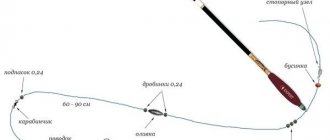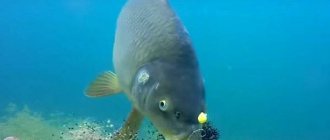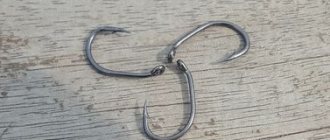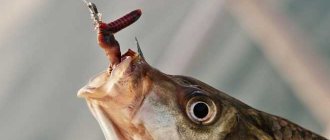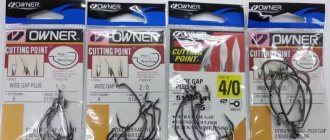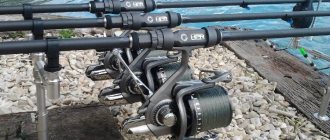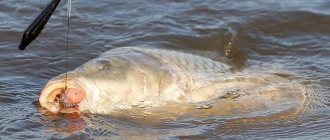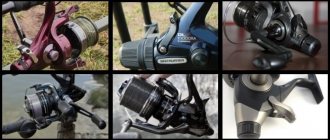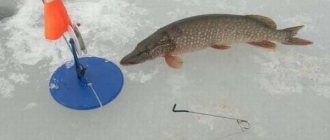In this review, we want to discuss the main forms of a hook-shaped tool, its distinctive characteristics from the general arsenal of fishing tools, their advantages, features, dimensions and materials of manufacture, in general, everything that will equip a novice carp angler with information for a successful hunt.
Content
- 1. Characteristics of carp fishing hook
- 2. Characteristics of the elements of carp hooks
- Hook tip
- Hook beard
- Hook shank
- Bend the hook
- Hook with inward eye
- Hook with an eye bent back
- Hook with straight eye
- Hook with a long and inwardly curved shank
Hook cover
The type of coating for hooks adds the following properties:
- Smooth surface due to low friction force and better penetration;
- Prevents the reflection of sunlight or other light, which reduces the vigilance of fish and scares them away less.
For carp, hooks with a matte finish and non-glare work best.
As you can see, unfortunately there is no universal solution; choose carp hooks that suit the fishing conditions.
Feature of Carp Fishing Hook
What is a fishing hook for? That's right, for attaching bait, hooking and holding prey when fishing.
Plus, this element of carp equipment has its advantages over other fishing hooks:
- It is attached to the nozzle using hair accessories.
- The task of the hook is to hook the fish itself, which occurs not thanks to the efforts of the fisherman, but due to the mass of the weight used, attached to the equipment.
- Reliability and sharpness.
Choosing the hook size for carp/carp
The hook size for carp fishing is selected based on the bait used:
- №1 – №2 – when fishing with dumplings, pasta or shellfish meat, as well as potatoes.
- №4 – when fishing with vegetable baits – corn, beans. Also No. 4 is used when fishing for maggots.
- №6 – for packing larger grains of corn, peas and pearl barley.
- №8 – for fishing with wheat or larger peas, as well as when attaching bunches of maggots.
Attention! When fishing with a worm, the hook size should be selected based on the size of the bait. Large crawlers are mounted on No. 2, ordinary earthworms - on No. 4, but for dung worms it is better to use No. 6.
When fishing with boilies, the size of the hooks is selected as follows - one third or half of the diameter of the boilie used should be equal to the distance between the shank and the hook tip.
Characteristics of the elements of carp hooks
2.1 Hook point
Hook point location options:
- direct;
- bent outward;
- bent inward.
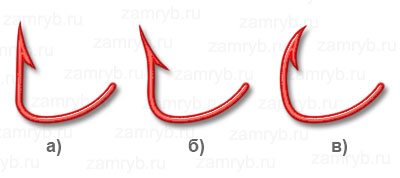
A straight tip is a classic option that is preferred by many carp anglers. The one bent outward is practically not used. The inward-facing tip is used in the same percentage as the straight tip. Its only advantage is considered to be a reliable hook on fish due to its peculiarity.
The most important thing for this part of the hook is its sharpness. Now let's explain why.
Due to its “gluttony”, carp is constantly in search of food, constantly plowing the bottom of the reservoir. Armed with their “food radar” in the form of various receptors located not only in the mouth, but also on the antennae, fins, lips, etc. he carries out tasting and evaluates the quality of the found delicacy, sucking and spitting out edible particles floating in the water. If the carp is above your boilie, it begins to suck it along with the hook. When the lead rig is pulled, the fish feels resistance and if it doesn’t like the food you offer (for example, a dung worm), it will instantly spit it out. It is at this moment that the hook should instantly turn with its sting downwards and firmly pierce the lower lip of the prey. The question of the speed of rotation of the equipment element indicates the correctness of its installation, but the question of high-quality notching is exclusively decided by the degree of sharpness of the “tool” that you prepare before the fishing process. Having been pricked with a tip, the carp tries to get rid of the inconvenience that has arisen and shakes its head, thereby loosening the fishing trap in the form of a hook. All this underwater struggle occurs even before the fisherman reacts, and at the moment the carp is released, the hook, under the influence of the weight of the weight, is pierced into his lip, which also requires special sharpness.
Carp - how and where to catch in Israel and not only: fishing techniques, tackle, bait, read here
For this reason, experienced carp anglers pay great attention to the sharpness of the fishing hook tip. The check is carried out at the stage of manufacturing the leader equipment and with each cast.
How to check the sharpness of a hook?
Once you have set the hook in the desired position, move the tip to the edge of the nail and if it slips, it means it needs sharpening. Upon visual inspection (using a magnifying glass), the tip should not have any chips, burrs or irregularities. To perform a contact test, run the pad of your thumb along the side surface of the tip from bottom to top.
2.2 Hook beard
We will answer this question as follows. “Beardless” hooks are effective at the initial stage of hooking (penetrating) into one of the carp lips, but already at the stage of landing the fish, the absence of this element can cause loss of prey.
Read more about what the barb of a fishing hook is and what function it performs here.
2.3 Hook shank
Hooks for catching carp can be with a short or long shank. It is believed that fast hooking can only be achieved thanks to a hook with a long shank, especially when catching neat and inactive fish, which is its advantage. The disadvantage of this design feature of the hook is visibility in the water, heavy weight and unreliable hook. We do not recommend using a hook with a long shank for fishing in snags and vegetative areas of the reservoir.
If, for example, you are on a body of water where there is active carp fishing, then under such circumstances the prey is cautious, which means that in this situation it is better to use a fishing hook with a shorter shank, and a hook with a long shank in case of active bite.
2.4 Hook bend
A carp hook can have a wide bend, which affects the gripping area of the soft tissues of the carp’s lips and, accordingly, makes the hook better. The scope of application of this design is fishing with floating boilies, and is also used in zig-rig equipment.
For fishing with a zig-rig rig, fluorocarbon fishing line is used due to its rigidity. If, for example, you tie a hook with an internal eye with a wide bend (gap), you will get a sharp angle for the notch. If you use the same hook, but with a different eye (bent outward), you will get a good hook angle and an equal bend, which contributes to its quality.
On the other hand, such a bend makes the equipment element less strong than a narrow one. We believe that the best option is a carp hook with an average width of this hook element.
Hook size and catch size
Before fishing, questions may arise about which hooks are the most suitable, what new products have appeared in the retail chain. Ovner products are in demand due to their high strength. In general, hooks come in different sizes - small and large.
Which one is better to take depends on the circumstances:
- Depending on the bottom topography, which can be soft silt or grass carpet.
- Fish can be weakly active.
- The fact that the fish's lips are thick and hard is taken into account.
- Character of the bite.
- Even the property of the metal used affects the result.
By design, hooks come with a ring-shaped eye or a spatula. Experts say that to get a trophy you need a ring, this is the most reliable means. The strongest hooks are suitable for carp; most often, tackle is specially made using the forging method. Fishermen are more willing to use products with numbers from 2 to 8 in their practice. But there is no single solid numbering system. Rods are also different. Fishing for carp on a feeder is notable for its unusual rod. The flexible upper part of the fishing rod is a kind of bite indicator.
Shapes of carp hooks
To catch one of the most “sporty” freshwater inhabitants, more than one type of fishing hook is used, and this is due, first of all, to the variety of equipment used for catching cyprinids. What features and advantages does each type of fishing hook have in carp fishing? Let’s look at it below.
3.1 Hook with inward eye
This is what this type of hook looks like
What is special about this form? Firstly, it is the most common solution when preparing most carp rigs, and secondly, such a hook is an aggressive comrade that perfectly detects fish, thanks to its ability to turn around when the fishing line is pulled and firmly cling to the lip of the prey. However, they have one drawback - due to their “agility”, when fishing for carp, they greatly tear up the place of the hook, increasing it, which often leads to the fish moving away, since the hook simply slips out.
3.2 Hook with an eye bent back
In the windows of fishing stores you will find a carp hook of this shape
You will need a hook with such an eye “turned” in the opposite direction if you are using a rigid (steel) leash, so that when it hits the bottom of the reservoir, it remains in its unchanged position, namely at the correct angle of attachment to the bait and all other equipment. In this position, the delicacy offered to the carp looks most presentable, which it will not be able to refuse and will not vomit when tasting it.
Read all about fishing leashes: material, types, installation and storage - here
3.3 Hook with straight eye
Most likely, you will not find such hooks in carp anglers’ rigs. They are simply not used by them. However, let's look at their features. Their main purpose is to catch large trophies in the upper layers of water. The difficulty of their practical use is that you have to constantly control the position of the hook, so that it is always on the back side of the nozzle, so that the fish swimming up from below simply does not notice it.
If you use a heat-shrink tube, the ability to accurately detect prey on this hook will increase significantly. This tube must be bent so that the hook faces its end. But the disadvantage of this maneuver is that everything takes time and the result is a rather inconvenient design.
3.4 Hook with a long and inwardly curved shank
These hooks are often called "banana" hooks due to their shape. Doesn't it really look like this fruit?
They are among the effective forms of carp fishing hooks. Their advantage is the ability to easily rotate on the equipment, which facilitates quick notching in the inside of the oral cavity. Area of application : catching large and cautious representatives of the carp dynasty. The equipment is short leashes made of soft material, which smoothly sink to the loaded bottom of the reservoir. The disadvantage is that they can greatly damage the oral cavity of the fish, for this reason many fishermen do not keep them in their arsenal.
Types of hooks for carp and carp
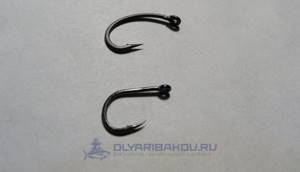
There are the following types of carp hooks:
- Wide Gap . the tip of which slightly curved inward for comfortable fishing in reservoirs with an abundance of bottom vegetation, as well as preventing its premature wear when fishing on a rocky bottom .
- Banana. This model has a long curved fore-end, shaped like a banana. The main feature is excellent carp hooking, but it is also a disadvantage, since due to the long lever there is a high probability lip tearing or the hook breaking even with moderate force. Often sports fishermen refuse this model because they believe that the “banana” is too traumatic for the carp.
- Long Shank. A model that also has a long fore-end, but, unlike the previous model, it is straight. It catches carp well, most often just by the lower lip , but it has the same disadvantages that are inherent in the “banana” - it easily injures the fish, tearing its lip, and is also susceptible to fracture.
- Curve Shank. A universal model with a wide-curved fore-end of medium length. Suitable for both sinking and floating baits. Particularly convenient for attaching several boilies to a hook.
- Short Shank. A hook that has a short shank and very little hooking. Used in difficult fishing conditions - among snags, abundant vegetation and on a rocky bottom. This model allows you to avoid frequent snagging on foreign objects and keeps the tip sharp for longer, however, it also has a consequential drawback - this form somewhat reduces the effectiveness of hooks.
What are the sizes of carp hooks?
Let us immediately note that the size of carp hooks is indicated according to the international classification, a characteristic feature of which is the absence of a unified approach to marking. The size indicated on the package is a relative indicator, and each manufacturer has its own vision of this parameter.
See for yourself. Below are hooks of the same size, the difference is obvious
Usually in carp fishing, experienced fishermen use hooks of sizes 8-2 (as the hook number increases, the size decreases). The main thing when choosing the right size is that it must correspond to the size of the nozzle; the larger it is, the more powerful the hook is required and vice versa.
Approximate hook to boilie ratio:
- no less than No. 8 – for nozzles with a diameter of 12 to 14 mm;
- no less than No. 6 – from 16 to 18 mm;
- no less than No. 4 – from 20-24 mm.
Methods for selecting hooks
When fishing with a feeder or float, where the hooking is done quickly and sharply, you must use ordinary hooks that are suitable for catching any other fish. Otherwise, the choice should be approached very carefully. Experienced people who use boilies to attract carp understand that the mechanics of biting are sometimes very difficult, so before choosing hooks you should first pay attention to this point.
Choosing a hook when fishing with boilies
First, the fish swims up to the boilie, which lies on the bottom. Having sniffed the bait, the carp begins to absorb it or immediately takes it into its mouth. Along with the treat, a hook hidden in the product also enters the mouth. After this, the fish begins to swim to the side in order to move away from the place where it refreshed itself. At this moment, the leash tightens, and the boilie is ready to fall out of the river inhabitant’s mouth. Given the unusual design, due to the weight of the sinker and the sharpness of the hook, the lip of the fish should break through. If you use reliable carp hooks, they will not bend or break.
Read more about the technique of catching carp with boilies and choosing bait.
This is why it is so important to choose proven elements, because otherwise the part will fail at the most inopportune moment. The first thing fishermen pay attention to is the strength of the product. When purchasing, you need to take this into account so that during fishing the fish does not get away “from under your nose.” High-quality elements are parts that are made of heavy-duty wire. Among the exceptions are only light models that are intended for floating boilies.
It must be said that strength can be achieved through proper processing of parts, during which first hardening occurs, and then sudden cooling. A high-quality element is springy, but at the same time it does not bend, much less break, unless, of course, the permissible load is exceeded.
What size should it be
Having dealt with the density, you can move on to the size. The carp hook, or rather its size, depends directly on the size of the boilie. So, the width of the hook can be two to three times the diameter of the ball. If you overdo it with hooking, then, most likely, the fish will feel the coldness of the metal when it starts to swallow the boilie and will abandon this idea, sensing something is wrong. The same applies to parts with a narrow underhang, because they will not be able to catch on the lip of the fish at all.
Hook sharpness
The sharpness of the hook also plays an equally important role. In order for the product to be perfect, it must be chemically or laser sharpened. There are anglers who prefer to catch carp with Chinese hooks - they are inexpensive, but often fail. Of course, everyone chooses products for themselves, but it is better not to skimp on such details.
Important! You can check the sharpness of the hook right in the store. To do this, you should place the point on the nail and try to draw the hook along; if the product sticks, the sharpening is correct; if it slips, the part is dull.
Experienced people recommend resorting to this manipulation not only during purchase, but also before every fishing trip, because hooks tend to become dull, and there is nothing strange about this.
The next point that is worth paying attention to is invisibility. Having noticed a boilie at the bottom, the carp must be sure that there is something tasty waiting for it there, and there is no trick in it. That is why the hook should be invisible among other elements and everything that is at the bottom.
This can be done in several ways. Firstly, it is advisable to use black parts. You should also pay attention to having a matte finish. Secondly, the size must correspond to the bait, this is what was discussed above. The most popular number is 6 . Although eight and ten are also used, based on the international classification. The sixth size is suitable for large boilies, and the tenth for small boilies.
Important! If there are difficulties and the fisherman does not know which carp hooks to choose, it is better to first purchase boilies and go from there.
Novice fishermen do not pay attention to the catchiness, but in vain. It should be noted that this nuance depends on the shape of the hook itself, as well as on the installation of the boilie on the hair.
Useful tips
When handling this sharp part of the carp equipment, we recommend that you take extra care to avoid injury during installation of the equipment and its direct use.
What to do if a hook is stuck in your hand and there is no way to get to a medical facility:
- You need to cut the hook from the rig.
- Next, you need to try to bite off the sting with the beard; if this fails, you need to press the beard to the sting for ease of removal.
- If the hook is successfully removed, disinfect the wound and cover it with a plaster or wrap it with a bandage.
If you have checked the tip of the hook for sharpness and identified defects, then it is better not to attach such a hook to the equipment, but to discard it altogether.
How to tie a hook to a fishing line
Particular attention should be paid to the installation of hooks, as well as their shape.
It is advisable to start with the classic form. The presented elements have a bend that runs parallel to the fore-end. It also has a ring that is slightly concave inward. In order for the carp to hook better, it is recommended to pull the hair through the tube and leave a distance of about 10 mm from the boilie to the bend. This is the ideal distance that will prevent the fish from pushing back. Very often, carp fishing is done with just such a hook, because it is considered one of the most popular. By the way, it is better for beginners to pay attention to the presented elements.
Read our selection of 29 ways to knit hooks to fishing line.
On sale you can find hooks with a sting curved inward. They are good to use where there is a lot of vegetation and all kinds of snags at the bottom. Due to the small bend, the likelihood of catching something is minimal.
Special hooks are also made for floating boilies, where the balls, one might say, stick to the fore-end. By moving the treat along the fore-end, you can ensure that the sting is at an angle of 45 degrees relative to the bottom. This design is catchy. Hooks for catching carp in this case are made of thin wire. This was done for good reason, so that the hair structure was not so bulky and heavy.
Experienced fishermen know that to ensure good grip, they use special heat-shrinkable tubes in carp fishing, which help with the bite and position the hook in the desired plane. In order to tie tubes, you need to put them on the hook ring and the end of the leash, bringing the element behind the shank to a point opposite the beginning of the tip of the hook.
Installing heat shrink tubing is not difficult. If, after assembly, you place the element on your palm and when pulling, pulling the end of the leash, it turns out that the hook turns with its tip towards the palm, then everything is done correctly. If something is wrong, then you need to check everything carefully.
When buying hooks, you need to pay special attention to them, so that at the most opportune moment it does not turn out that the elements are of poor quality or that they do not fit the existing bait at all.
iarybak.ru
Where did each hook perform best?
Curve Shanks with long forend (Mugga, Curve Medium) - Ronnie rig, 360 rig
Long Shank with a long shank (Incizor or with thickened wire Korda Longshank) - Blowback rig Wide Gape rig (we use soft material with a curved sting and a stiffer material with a straight sting) - classic carp leader
Curve Shank - D rig
Chod Hook - Chod rig and Hinged Stiff rig equipment (chod rig with a bend made of regular leader material)
Basic concepts. How is the strength of the hooks achieved?
Two things. The first is forging. Its thickness. The thicker the bend, the stronger the hook. Currently, many manufacturers have consoles X, XS and the like. This means a thicker version of a particular model. If you are going into harsh fishing conditions, you may want to use a stronger hook.
The second is the production process itself. Due to minimal technical tolerances, almost all manufacturers have long made their hooks in Japan. Where each product undergoes a strictly defined alloying process to the highest standards. Almost all self-respecting companies that do not want to lose face in front of the consumer send their drawings to Japan.
Be sure to pay attention to the hardening method and where the hooks were made.
